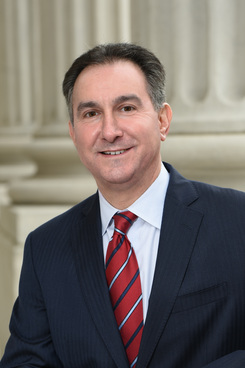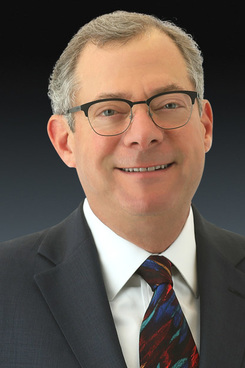How Will Post-Lockdown Law Offices Look?
"Nobody is going back to 900 square feet per lawyer or 300 square feet per person."
May 01, 2020 at 09:00 AM
10 minute read
 Bigstock®
Bigstock®
Work-from-home measures undertaken during the novel coronavirus pandemic have led some law firms to question whether their brick-and-mortar offices are too big, because of now-battle-tested remote work capabilities, or too small, because of what look to be long-term social distancing concerns. While the issue is driving conversation, it's unclear whether it will manifest in true philosophical or strategic changes when it comes to physical space and real estate.
One small New Jersey firm is less focused on the long term and more concerned with short-term measures for office safety.
"You know you can't flip a light switch and everything is good, and everyone goes back in," said
 Andrew Statmore of Fredson Statmore Bitterman in Bloomfield, New Jersey.
Andrew Statmore of Fredson Statmore Bitterman in Bloomfield, New Jersey.Andrew Statmore of Fredson Statmore Bitterman, a plaintiffs firm located in a four-building office park in Bloomfield. While his firm's lease was just recently negotiated for another 10 years, there are immediate concerns amid COVID-19 and what to do after the lockdown.
The firm occupies the first floor of one of the buildings—3,300 square feet of office space for 15 employees—and has cubicles stacked against each other, split evenly four and four, directly facing each other and in the middle of the office. That's "the bullpen," and there are five attorney offices around the outside of it. It likely doesn't allow for strict conformity with social distancing guidelines that have been put in place, Statmore said.
"Employees are looking directly at each other" in the cubicles, he said. "And there is someone to your right and left. There's not a whole lot of room to avoid people. It's nearly impossible."
Statmore has been working from home, going into the office only on Sundays to retrieve two file boxes each visit.
"It certainly is something we're thinking about," Statmore said of shifting back to office work.
In the long term, many of the concepts that have become commonplace in law firm real estate already had firm leaders thinking about efficiency and a smaller footprint. Because of that, adjustments are more likely to occur than shifts, according to architect Anthony Colciaghi, who for 35 years has done design work for law offices.
"From a space design standpoint, I think you'll see temporary measures to deal with this acute period" rather than a long-term shift in how space is used at law offices, said Colciaghi, of Francis Cauffman Architects, which does work for many law firms, including in New Jersey.
Uniform-size attorney offices, more glass walls and common areas, and "core space" in the office center, once devoted to paper, now used as workspace for staff and junior attorneys—"all of those trends are now mainstay, and they're not going to go away," Colciaghi said.
Most firms strive for less than 650 square feet per lawyer, and some with offices in particularly expensive markets such as New York, Los Angeles and Chicago shoot to be in the 500s, "and that's achievable," he said, depending on a firm's practice areas and how its attorneys work together.
The "big shift" now, he said, is examining whether office spaces allow for social distancing, like Fredson Statmore is doing.
Law offices are typically "cellular use" spaces, with perimeter single offices and no "benching workstations" of the type seen at a technology firm, Colciaghi said. In that way, law firms are "at a little bit of an advantage" when it comes to safely returning to work, he said.
When it comes to post-shutdown adjustments, "a lot of it is commonsense strategies," such as "checkerboard" work spaces that allow for more space, he said.
"Most people that have design projects underway—I haven't heard of anybody scrap the design approach," he said. "Nobody is going back to 900 square feet per lawyer or [going down to] 300 square feet per person."
As for whether law firms trend more toward hoteling—where, for example, for every 10 attorneys there are seven offices, and workspace must be reserved ahead of time—that remains to be seen, and likely won't be pushed too far by the pandemic, he said.
"That's kind of a concept you see in other industries, but that requires a clean desk policy … and a desk reservation system," Colciaghi said. "If you're a Boston to Washington firm … that really works well."
Some firms are already there. For example, the Bedminster office of Philadelphia-based Weber Gallagher Simpson Stapleton Fires & Newby operates largely on hoteling: It is the home office for 25 lawyers, but the office only has room for about 20, and workspace is reserved ahead of time, with lawyers typically going to the office once per week. Firm chairman Andrew Indeck recently told Law Journal affiliate the Mid-Market Report that more firms "are all of a sudden realizing, hey, we're actually really productive this way." He added, "Virtually everybody has seen the light."
But the more immediate question for most firms is when—and more importantly, how—to return to the office.
 John Fanburg of Brach Eichler in Roseland, New Jersey
John Fanburg of Brach Eichler in Roseland, New Jersey"I think we are OK with our space," said John Fanburg, managing partner at Brach Eichler. Brach Eichler is a major tenant in one of three buildings at 101 Eisenhower Parkway in Roseland and occupies almost the entire second floor—making it that building's largest tenant. Everyone at the firm has their own office separated by a wall, while some administrative staff work in individual cubicles.
"When we go back, we will have to think about the spacing. I don't think we need to rush back to the office," Fanburg said in a recent phone interview. "It's the psychological aspect. I think we can be very deliberate in returning to the office and maintaining the safety of our staff."
"If it's not possible to space apart, maybe I can stagger days when people are in and people are out. We are starting that discussion with my managing director [Harry Katz] on how we stage coming back to the office," Fanburg said. "We are consulting with physicians to tell us how to handle this as we migrate back to the office."
Brach Eichler has been nearly 100% remote since March 17.
Working remotely "really doesn't change the business of law a whole lot," but "the practice of law is a team sport," Fanburg said. "In order to be a good lawyer, you have to collaborate with colleagues. You have to meet and see clients in order to develop rapport and trust to help them."
Meetings go on via Zoom and other platforms, "but that does not replace meetings and seeing people in person, and developing that three-dimensional rapport in relationships," he said.
Fanburg said the firm is staying current on rent, while it watches its pipeline of work and its expenses. "I think I'm sensitive to the landlords who have mortgages, and we have payroll and other things."
"Based on the governor and health officials and scientists, we will go back when it's safe to do so," Fanburg added. "Getting the technology and getting people used to this was a bit bumpy. But the transition has gone well since, and I get nothing but huge compliments [about] the IT team."
Well before the current pandemic's impact on legal work, Connell Foley in Roseland took steps to change its office footprint, managing partner Philip F. McGovern Jr. said.
"Two years ago we moved into our new space at 56 Livingston, which is substantially more efficient than our previous location," McGovern said. "Attorney office space is uniform, open space areas are much more plentiful and accessible, and the upgrades to our technology platform were substantial, all leading to greater efficiencies in the use of our space."
The firm's attorneys and staff are 100% remote except for "rotating skeleton administrative crews in each of our offices for business continuity purposes, and from time to time, attorneys will be in the office to pick up files and attend to other matters."
Still, despite a largely emptied office, McGovern said the firm has not made any decisions on its future real estate needs based on the current climate.
"At this time no," McGovern said. "We are too early in the game to make any determinations about long-term space needs."
At Genova Burns, the transition to remote work has been seamless, and all 70 attorneys have been working from home, according to Angelo Genova, chairman and managing partner. He said the firm has long valued technology, and that investment has paid off during the pandemic. Genova Burns occupies the fifth and sixth floors of 494 Broad Street in Newark. The firm's name is on the building.
"Like many other businesses, we are eager to return to the workplace and business normalcy, but only in a manner that respects the concerns of our team at Genova Burns," Genova said in a recent interview. "How our office will accommodate and respond to those concerns will be informed by protocols for the return to work yet to be solidified."
"We will take our guidance from the professionals and experts charged with providing a safe path for the future," added Genova. "[Office] space and its configuration will likewise be driven by these protocols. We look forward to returning to Newark."
'Have you ever considered consulting?'
When it comes to the specifics of returning to the office, an expert opinion might help. Brach Eichler, which has many health-care industry clients, has asked for advice from one of them, Fanburg said: an infectious disease expert he recruited in early March to consult the firm on creating a safe work environment after the lockdown is lifted.
"He's been a client for the best part of the decade, and now I am client of his," Fanburg said. "When this all happened, we started having a discussion, and I asked him, 'Have you ever considered consulting?' I told him I was willing to pay. So we entered into a consulting arrangement, and he's been very helpful in weeding through the nonsense."
"So now, I have a doctor to guide me on whether this is a good idea or a bad idea, and what should we do for the office," Fanburg said.
"I don't have Dr. Fauci," quipped Fanburg, referring to Dr. Anthony Fauci, director of the National Institute of Allergy and Infectious Diseases who is advising the White House on COVID-19. "But I have him."
This content has been archived. It is available through our partners, LexisNexis® and Bloomberg Law.
To view this content, please continue to their sites.
Not a Lexis Subscriber?
Subscribe Now
Not a Bloomberg Law Subscriber?
Subscribe Now
NOT FOR REPRINT
© 2025 ALM Global, LLC, All Rights Reserved. Request academic re-use from www.copyright.com. All other uses, submit a request to [email protected]. For more information visit Asset & Logo Licensing.
You Might Like
View All
Retiring AOC Director Judge Glenn A. Grant Walks Away From Judiciary 'Tremendously Impressed' by New Jersey's Judges
5 minute read
Smaller Firms in 'Growth Mode' as Competition, Rates Heat Up


NJ Jury Awards $8M to Woman Injured by Employees Chasing Suspected Shoplifter
3 minute readLaw Firms Mentioned
Trending Stories
- 1Decision of the Day: Trial Court's Sidestep of 'Batson' Deprived Defendant of Challenge to Jury Discrimination
- 2Is Your Law Firm Growing Fast Enough? Scale, Consolidation and Competition
- 3Child Custody: The Dangers of 'Rules of Thumb'
- 4The Spectacle of Rudy Giuliani Returns to the SDNY
- 5Orrick Hires Longtime Weil Partner as New Head of Antitrust Litigation
Who Got The Work
J. Brugh Lower of Gibbons has entered an appearance for industrial equipment supplier Devco Corporation in a pending trademark infringement lawsuit. The suit, accusing the defendant of selling knock-off Graco products, was filed Dec. 18 in New Jersey District Court by Rivkin Radler on behalf of Graco Inc. and Graco Minnesota. The case, assigned to U.S. District Judge Zahid N. Quraishi, is 3:24-cv-11294, Graco Inc. et al v. Devco Corporation.
Who Got The Work
Rebecca Maller-Stein and Kent A. Yalowitz of Arnold & Porter Kaye Scholer have entered their appearances for Hanaco Venture Capital and its executives, Lior Prosor and David Frankel, in a pending securities lawsuit. The action, filed on Dec. 24 in New York Southern District Court by Zell, Aron & Co. on behalf of Goldeneye Advisors, accuses the defendants of negligently and fraudulently managing the plaintiff's $1 million investment. The case, assigned to U.S. District Judge Vernon S. Broderick, is 1:24-cv-09918, Goldeneye Advisors, LLC v. Hanaco Venture Capital, Ltd. et al.
Who Got The Work
Attorneys from A&O Shearman has stepped in as defense counsel for Toronto-Dominion Bank and other defendants in a pending securities class action. The suit, filed Dec. 11 in New York Southern District Court by Bleichmar Fonti & Auld, accuses the defendants of concealing the bank's 'pervasive' deficiencies in regards to its compliance with the Bank Secrecy Act and the quality of its anti-money laundering controls. The case, assigned to U.S. District Judge Arun Subramanian, is 1:24-cv-09445, Gonzalez v. The Toronto-Dominion Bank et al.
Who Got The Work
Crown Castle International, a Pennsylvania company providing shared communications infrastructure, has turned to Luke D. Wolf of Gordon Rees Scully Mansukhani to fend off a pending breach-of-contract lawsuit. The court action, filed Nov. 25 in Michigan Eastern District Court by Hooper Hathaway PC on behalf of The Town Residences LLC, accuses Crown Castle of failing to transfer approximately $30,000 in utility payments from T-Mobile in breach of a roof-top lease and assignment agreement. The case, assigned to U.S. District Judge Susan K. Declercq, is 2:24-cv-13131, The Town Residences LLC v. T-Mobile US, Inc. et al.
Who Got The Work
Wilfred P. Coronato and Daniel M. Schwartz of McCarter & English have stepped in as defense counsel to Electrolux Home Products Inc. in a pending product liability lawsuit. The court action, filed Nov. 26 in New York Eastern District Court by Poulos Lopiccolo PC and Nagel Rice LLP on behalf of David Stern, alleges that the defendant's refrigerators’ drawers and shelving repeatedly break and fall apart within months after purchase. The case, assigned to U.S. District Judge Joan M. Azrack, is 2:24-cv-08204, Stern v. Electrolux Home Products, Inc.
Featured Firms
Law Offices of Gary Martin Hays & Associates, P.C.
(470) 294-1674
Law Offices of Mark E. Salomone
(857) 444-6468
Smith & Hassler
(713) 739-1250






